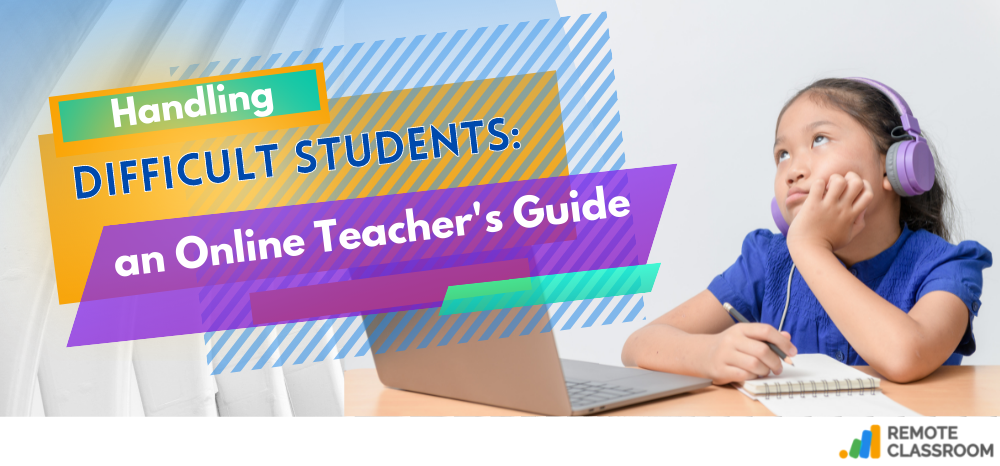You must be prepared when it comes to dealing with difficult students in an online classroom. Being an online teacher can be challenging at times, but it can also be quite rewarding.
With planning, being flexible, and having a good sense of humor, you can handle these so-called tricky or tough pupils and emerge with improved classroom management abilities!
What are the characteristics of a challenging student?
Students may be bored, young learners may have short attention spans, teenagers may be eager to impress their peers, and adults may lack confidence in their speaking ability. However, the most important thing to remember is that just because a student is acting out doesn’t indicate they’re a horrible student when dealing with problematic students in the classroom, whether online or in-person.
How to Teach Rude/Bored Students. Video from Youtube.
These pupils can be controlled, whether they only need a little extra attention or a place to channel their energy or passion. Further, they deserve the same amount of work and respect as any other kid.
The Most Common Behaviors of Difficult Students
Many of these student behaviors will be familiar to online professors. Here are some suggestions for dealing with each of them:
Basic Etiquette Is Missing
Some students may talk to you like they’re texting an adolescent pal, depending on your student demographic. Also, they are not permitted to use salutations, capitalization, or even complete phrases. Subsequently, there are various reasons for this type of hasty, abbreviated communication.

A bored and distracted student. Credit: kwanchaichaiudom on iStock.
Online students are frequently overcommitted and distracted, and generational communication norms may play a role. Of course, many students are not being disrespectful on purpose.
However, I still expect to see basic decency. I’m not typing while wearing white gloves, and I’m not expecting to be addressed as “Your Highness.” Civil dialogue, on the other hand, is a good place to start for a constructive teaching and learning partnership.
What you can do: Set a good example for others when it comes to email etiquette. Students will be more likely to follow your instructions if you do this. Also, double-check that your terminology accurately depicts the roles of an online instructor and learner. Use a semi-formal greeting and sign-off as well (I always start with “Hello” and close with “Kind regards” for a warm but professional tone).
You’re doubting your judgment or abilities.
This type of student behavior should be accompanied by a series of flashing warning lights. It’s a sensitive position because comments that question your professional abilities are upsetting. And it’s tempting to answer with a quick, harsh remark that puts the pupil in her place. This, on the other hand, is ineffective because it sours future relationships and gives you an unprofessional impression.

An overwork and tired teacher. Credit: Andrey Zhuravlev on iStock.
What you can do: Take a break from the keyboard if the statement is very offensive. Allow yourself to relax and regain some perspective. A knee-jerk reaction will set off a chain of angry emails that will lead to nothing useful.
Always anticipate that your response will be read by others. Also, your Program Manager will be notified if this becomes a formal complaint. Your conduct must be flawless.
This kind of comment is indicative of a lack of respect. Make sure your credentials and experience are listed in your Learning Management System profile. In your email signature, include your title and qualifications. Make it clear that you know what you’re doing and why you’re doing it.
Immediate and many responses are required.
Students may believe that online teachers are essentially on-call tutors. This is a common misconception among students. They may send a series of progressively frantic emails in the hopes of receiving a prompt answer.
Of course, the pupil could simply be nervous and require additional assurance. In an increasingly corporatized school system, she may be defending her right as a customer. In any case, expecting an immediate reaction is unrealistic.

A teacher responding to emails. Credit: diego_cervo on iStock.
What you can do: Timelines for communication should be established. In your Learning Management System, describe your normal email response time. It’s also worth noting that, rather than real-time instant chatting, online learning demands asynchronous communication.
Start with the most recent message in a long email chain. Often, the student will have received a response to her question earlier in the process, and you will just need to respond to the last email.
Expecting to be treated differently.
There are numerous valid reasons for online lecturers to give extensions or review essay drafts. However, there is a significant distinction to be made between fair requests and demands for special treatment.

A student having a discussion with her teacher. Credit: SyhinStas on iStock.
What you can do to help: On your Learning Management System, explain your policy on assignment deadlines and extensions. Students who need a third extension should go to that website. This shifts the discussion away from personal denial and toward a policy issue that affects everyone.
Stress that one-on-one attention is not always possible, especially in large gatherings. Furthermore, it is unethical to treat some students more favorably than others, and you want to maintain a level playing field. If you agree to read over several draft essays, for example, make it clear that you will do it when you have the time. This task will also not be put to the top of your to-do list.
Takeaway
These strategies will make it easier for you to deal with difficult students. It’s a tiny but substantial improvement that can help online teachers have the happy working environment they deserve.
Remote Classroom is a remote teaching monitoring program that will assist and guide you in keeping track of your students’ activities, assignments, and chores with ease.
#remoteclassroomph
#remoteclassroom
#remotelearning
#remoteeducation
#remoteschools
#onlineteachers
#onlinetutoring
#virtualteaching
#lifeschooling
#intentionalschooling
#virtualclass
#onlinelearning
#homeschooling
#virtuallearning
#onlineschools

